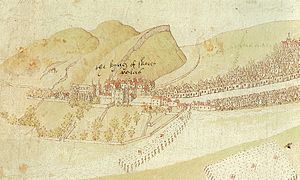Richard Lee (engineer) facts for kids
Sir Richard Lee (born in 1513, died in 1575) was a very important military engineer in England. He worked for three famous English rulers: Henry VIII of England, Edward VI, and Elizabeth I. He was a leader for King Henry VIII and was in charge of the King's building projects. In 1545, Lee also became a member of parliament for Hertfordshire, which meant he helped make laws. He was the first engineer in England to be made a knight!
Contents
Building Strongholds in Calais

From 1536 to 1542, Richard Lee was in charge of building projects in Calais, a town in France that belonged to England back then. He took over from William Lilgrave. Lee might have started as a master builder, and he became more important thanks to Thomas Cromwell, a powerful advisor to the King.
In 1538, Lee came back to England. He helped Thomas Wriothesley change Titchfield Abbey from a religious building into a home. After St Albans Abbey was closed down, Lee bought the land where it stood. He also bought Sopwell Priory and the church of St Stephen's.
Lee tore down Sopwell Priory and built a new house there in the Tudor style. He called his new home Lee Hall. He also bought the land known as the manor of Abbots Langley.
By 1539, Lee was back in Calais. He was working on new plans to make the town's defenses stronger, which King Henry VIII had designed earlier. Since there was only brick in Calais, Lee had special stone and wood shipped from Kent in England. He even used materials saved from old monasteries that had been taken apart, like Faversham and St. Augustines in Canterbury. Lee built a new harbor at Dykeland on the Hammes river for the ships bringing materials. In 1541, he started building a special three-leaf-shaped fort called the Dublin Tower.
Military Work in Scotland

During a war with Scotland called the Rough Wooing, Richard Lee was sent to Scotland in January 1544. He went with two Italian engineers, Antonio da Bergamo and John Thomas Scala. They were experts at building defenses. Lee joined Lord Hertford's attack on Edinburgh in May 1544.
Lee said that Edinburgh Castle was too strong to capture. He drew maps of Edinburgh and Leith. Lord Hertford made him a knight at Leith. It is thought that Lee took a special reading stand, called the Dunkeld Lectern, from Holyrood Abbey during an attack on Edinburgh in 1544. He definitely took a brass font (a bowl used for baptisms) from Holyrood. This font, which Scottish kings were baptized in, was later at St Albans. It had Lee's name and the story of how he captured it in 1544 carved on it, but it is now gone.
After the battle of Pinkie Cleugh in September 1547, Lee was put in charge of all the King's building and defense projects in the North of England. He held this important job for the rest of the war with Scotland.
Protecting England's Coasts

Around 1550-1552, Lee worked at Berwick-upon-Tweed. He built new types of defenses there called trace-italienne fortifications. These forts had star shapes to help defend against attacks. In 1557, he was a trench-master for the Earl of Pembroke in the Netherlands. In 1558, he went back to Berwick as the Surveyor of Works.
After working at Portsmouth, Richard Lee was again in charge of making Berwick's defenses stronger in 1560. He communicated with Rowland Johnston and visited in April. His job was to "set forward the device for Berwick," meaning to design the new defenses. Lee also went to the Siege of Leith on April 27, 1560. He was asked to "prick them forward to an end," which probably meant helping to plan an attack on May 7 that failed. Lee made a map of Leith that was sent to London on May 15, 1560.
In June 1564, Queen Elizabeth I of England called Lee and a captain named Pelham to meet her. They might have been asked to talk about what happened at Leith. When Lee was in London during this time, he stayed at Mr. Graisse's house in Cheapside. In 1565, Lee looked at the site of Lindisfarne Castle on Beblowe Crag, likely to consider its defenses.
Key Projects and Fortifications
Sir Richard Lee worked on many important building and defense projects across England and in other places. Some of his notable works include:
- Berwick upon Tweed
- Calais
- Dover Harbour
- Harwich and Langar Point
- Lindisfarne Castle
- Siege of Leith
- Norham Castle; he worked here in July 1550 with Sir Thomas Palmer.
- Portsmouth
- Queenborough
- Roxburgh Fort
- Sandown, Isle of Wight
- Tynemouth Castle; he worked here in March 1545 with Gian Tommaso Scala and Antonio da Bergamo.
- Upnor Castle

